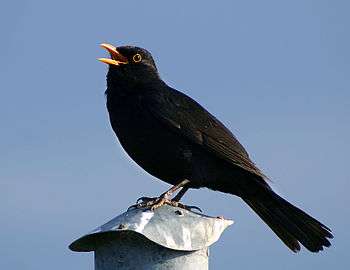Zoomusicology
Zoomusicology is a field of musicology and zoology or more specifically, zoosemiotics. Zoomusicology is the study of the music of animals, animal music or rather the musical aspects of sound or communication produced and received by animals.
Zoomusicology may be distinguished from ethnomusicology, the study of human music.
Definition
John Blacking defines animal music as, "sounds produced by other species that we can hear as organized," while Kathleen Higgins adds that humans must also be able to empathize with these sounds.[1] Zoomusicologist Dario Martinelli describes the subject of zoomusicology as the, "aesthetic use of sound communication among animals." George Herzog (1941) asked, "do animals have music?" François-Bernard Mâche's Musique, mythe, nature, ou les Dauphins d'Arion (1983),[2] includes a study of "ornitho-musicology" using a technique of Nicolas Ruwet's Langage, musique, poésie (1972),[3] paradigmatic segmentation analysis, shows that bird songs are organized according to a repetition-transformation principle. One purpose of the book was to "begin to speak of animal musics other than with the quotation marks",[4] and he is credited by Dario Martinelli with the creation of zoomusicology.[5]
Musicologist Marcello Sorce Keller attributes musical qualities to animal sounds, specifically whales' and birds' songs, by stating that regional variations can be found that resemble cultural traits in human music. He advocates for a combined study of zoomusicology and ethnomusicology with the remark that he, "would like to suggest that musical scholarship excluding non-human animals cannot ultimately describe 'how musical is man [sic]'."[6]
Human interaction
As a test of his theory of the emotional origins of music,[7] David Teie created species-specific music and tested it on cotton-top tamarin monkeys at the University of Wisconsin.[8] The results of the study, led by Charles T. Snowdon, indicate that the species-specific music written by Teie was the first music that was shown to be effective for any species other than human in a controlled study. Shinji Kanki composes music for dolphins according to conventions found in dolphin music or found to please dolphins in his Music for Dolphins (Ultrasonic Improvisational Composition) for underwater ultrasonic loudspeakers (2001).
Composers have evoked or imitated animal sounds in compositions including Jean-Philippe Rameau's The Hen (1728), Camille Saint-Saëns's Carnival of the Animals (1886), Olivier Messiaen's Catalogue of the Birds (1956–58) and Pauline Oliveros's El Relicario de los Animales (1977).[9] Other examples include Alan Hovhaness's And God Created Great Whales (1970), George Crumb's Vox Balaenae (Voice of the Whale) (1971) and Gabriel Pareyon's Invention over the song of the Vireo atriccapillus (1999) and Kha Pijpichtli Kuikatl (2003). The Indian zoomusicologist A. J. Mithra has composed music using bird, animal and frog sounds since 2008.[10]
Zoomusicologists
A number of researchers in fields ranging from music to semiotics to philosophy to biology are doing zoomusicological research, whether or not they call themselves biologists. American-born, Australian-resident musician and zoomusicologist Hollis Taylor has conducted an extensive study of the Pied Butcherbird over the past 15 years, including interdisciplinary research with philosophers and scientists. American clarinettist, improvisor, and philosopher David Rothenberg plays music with animals, and has written books on the relationship between bird, insect, and whale song and human music. Canadian-born, Scottish-resident composer Emily Doolittle has written numerous pieces based on animal songs, and has published interdisciplinary music-science research on the hermit thrush[11] and the musician wren.[12] Vienna-based cognitive scientist and evolutionary biologist Tecumseh Fitch has published extensively on the evolutionary origins of music, including in animal song. Pianist and researcher Patricia Gray has researched the music-making abilities of bonobos and runs a research program in Biomusic at University of North Carolina, Greensboro.
See also
- Bioacoustics
- Biomusic
- Biophony
- Animal communication
- Animal echolocation
- List of animal sounds
- Vocal learning
- Nora (cat)
References
- ↑ Higgins, Kathleen Marie (2012). The Music between Us: Is Music a Universal Language?, p.23. University of Chicago. ISBN 9780226333274.
- ↑ Mâche, François-Bernard (1983). Musique, mythe, nature, ou les Dauphins d'Arion [Music, Myth and Nature: or, The Dolphins of Arion, translated from the French by Susan Delaney (1992)]. Harwood Academic Publishers. ISBN 3-7186-5321-4.
- ↑ Ruwet, Nicolas (1972). Langage, musique, poésie (in French). ISBN 978-2-02-002041-1.
- ↑ Mâche, François-Bernard (1992). Music, Myth and Nature: or, The Dolphins of Arion. p. 114.
- ↑ Martinelli, Dario. "A Short Introduction to Zoomusicology".
- ↑ Keller, Marcello S. (2012). "Zoomusicology and Ethnomusicology: A Marriage to Celebrate in Heaven". Yearbook for Traditional Music. 44: 168. doi:10.5921/yeartradmusi.44.0166.
- ↑ Snowdon, C. T. and Teie, D. (2013). "9". In Altenmuller. Evolution of Emotional Communication. Great Clarendon Street, Oxford, OX2 6DP, United Kingdom: Oxford University Press. pp. 133–151. ISBN 978-0-19-958356-0.
- ↑ Snowdon, C. T. and Teie, D. (2010). "Affective responses in tamarins elicited by species-specific music". Biology Letters of the Royal Society B. Royal Society. 6: 30–32. doi:10.1098/rsbl.2009.0593. Retrieved 20 July 2014.
- ↑ Von Gunden, Heidi (1983). The Music of Pauline Oliveros. p. 133. ISBN 0-8108-1600-8.
- ↑ "Interview: a j mithra, Making Music with Animal Calls", IndiasEndangered.com. "The only known zoo musicologist in India and the second in the world after Jim Fassett who was known to create similar music from animal sounds way back in 1955."
- ↑ Doolittle, Emily; Gingras, Bruno; Endres, Dominik; Fitch, Tecumseh. "Overtone-based pitch selection in hermit thrush song: Unexpected convergence with scale construction in human music". Proceedings of the National Academy of Sciences. 11: 16616-16621. doi:10.1073/pnas.1406023111.
- ↑ Doolittle, Emily; Henrik Brumm. "O Canto do Uirapuru" (PDF).
External links
- Zoomusicology by Dario Martinelli
- Zoosemiotics - Animal communication on the web
- Zoomusicology by Hollis Taylor
